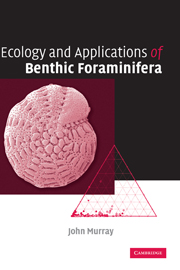Book contents
- Frontmatter
- Contents
- Preface
- 1 Introduction
- 2 Methods
- 3 Aspects of biology and basic ecology
- 4 Marginal marine environments
- 5 Shelf seas
- 6 Carbonate environments
- 7 Deep sea
- 8 Summary of living distributions
- 9 Taphonomic processes: formation of dead and fossil assemblages
- 10 Applications
- Glossary
- Appendix
- References
- Taxonomic Index
- General Index
6 - Carbonate environments
Published online by Cambridge University Press: 12 August 2009
- Frontmatter
- Contents
- Preface
- 1 Introduction
- 2 Methods
- 3 Aspects of biology and basic ecology
- 4 Marginal marine environments
- 5 Shelf seas
- 6 Carbonate environments
- 7 Deep sea
- 8 Summary of living distributions
- 9 Taphonomic processes: formation of dead and fossil assemblages
- 10 Applications
- Glossary
- Appendix
- References
- Taxonomic Index
- General Index
Summary
Introduction
In the majority of sedimentary environments, the biogenic carbonate is diluted by clastic detritus transported in by rivers and forms only a small proportion of the sediment. The distinctive feature of carbonate environments is that they are areas not receiving clastic detritus from erosion of land. Therefore the biogenic material slowly accumulates to form carbonate sediment. The fundamental difference between cool–temperate carbonates and those in shallow tropical areas is that the latter have chemically deposited or cemented grains (ooids, aggregates, hardened pellets) and may have aragonite mud. All these are absent from cool and temperate examples where the characteristic mineral is calcite. Carbonate sediments composed of bioclasts of molluscs, echinoderms, bryozoans, barnacles, foraminifera and red calcareous algae are present in cool, temperate and tropical regions, but hermatypic corals and green calcareous algae are confined to shallow tropical areas. Two broad terms have been introduced to distinguish these differences: heterozoan and photozoan, the latter with corals and green calcareous algae (James, 1997). The term photozoan reflects the importance of light for the symbionts of the fauna and for the free-living algae.
Warm-water carbonate environments
Seagrass communities
Seagrasses are marine flowering plants that occur in shallow, subtidal environments in tropical areas, and extend into the intertidal zone in temperate areas. They are strongly influenced by light and cannot live in water depths where the benefits from photosynthesis are less than the loss from respiration.
Information
- Type
- Chapter
- Information
- Ecology and Applications of Benthic Foraminifera , pp. 163 - 179Publisher: Cambridge University PressPrint publication year: 2006
Accessibility standard: Unknown
- 1
- Cited by
